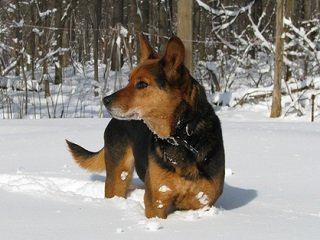 We tend to think that animals—especially dogs—are more comfortable in cold weather than we are. While this is true to a certain degree, your dog is just as susceptible to injury and danger as you are when it comes to cold temperatures. In fact, many don’t know that, like us, dogs can get hypothermia when conditions are cold, wet, and windy. There are a few signs to watch for to determine if your dog may be suffering from hypothermia, as well as what to do when symptoms appear, and today we’ll take a look at them.
We tend to think that animals—especially dogs—are more comfortable in cold weather than we are. While this is true to a certain degree, your dog is just as susceptible to injury and danger as you are when it comes to cold temperatures. In fact, many don’t know that, like us, dogs can get hypothermia when conditions are cold, wet, and windy. There are a few signs to watch for to determine if your dog may be suffering from hypothermia, as well as what to do when symptoms appear, and today we’ll take a look at them.
Similar to humans, hypothermia in dogs occurs in stages, with signs specific to each related stage. For instance, the signs of mild hypothermia include violent shivering and fatigue. Moderate Hypothermia brings with it loss of shivering ability, disorientation, stumbling movements, and even loss of consciousness. Finally, severe hypothermia signs include unconsciousness and ragged breathing.
If your dog begins to display any signs of hypothermia, there are a few key steps you can take to ensure it doesn’t escalate. These steps include the following: removing the dog from further exposure to the cold, warming your dog any way you can—your heated vehicle, blankets, or indoors—and transporting it to veterinary care. Don’t apply too much pressure to your dog’s body or place hot objects in direct contact with it. Also, don’t give your dog cold fluids. Properly rewarming a hypothermic dog is a delicate process, so perform the basic steps, but leave the rest to the vet.
You can take measures to prevent your dog’s risk of hypothermia before you even leave the house. For example, outfit your dog with an insulated vest and dog boots (it may take a while for your dog to get used to the boots, but it’s worth it). Furthermore, if your dog somehow gets wet, protecting your dog from the wind and towel drying it immediately will help. Finally, head indoors when conditions become extreme. If the weather is too bad for you to want to go out in the cold, then extend the same consideration for your dog.
Dogs can’t speak. They can’t tell us what’s wrong or warn us when they’re not feeling well. For this reason, it’s so important to really pay attention to your dog’s behavior and symptoms, especially when the outdoors are involved. Outfitting your dog for cold weather and monitoring its physical condition on the wintery trails can help ensure your best friend stays healthy and safe.








